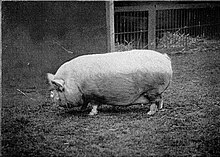
The Shiba Inu is a breed of hunting dog from Japan. A small-to-medium breed, it is the smallest of the six original and distinct spitz breeds of dog native to Japan. Its name literally translates to "brushwood dog", as it is used to flush game.

Collies form a distinctive type of herding dogs, including many related landraces and standardized breeds. The type originated in Scotland and Northern England. Collies are medium-sized, fairly lightly-built dogs, with pointed snouts. Many types have a distinctive white color over the shoulders. Collies are very active and agile, and most types of collies have a very strong herding instinct. Collie breeds have spread through many parts of the world, and have diversified into many varieties, sometimes mixed with other dog types.
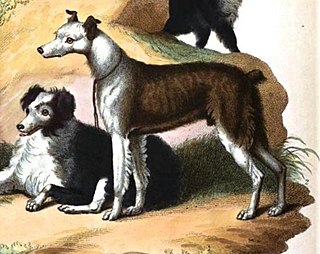
A cur was a dog breed used by cattle drovers in England. The breed is now extinct. In the United States a short-haired dog used in hunting and herding is called "cur-tailed", or "cur" for short.

The Gloucestershire Old Spots is an English breed of pig which is predominantly white with black spots. It is named after the county of Gloucestershire. The Gloucestershire Old Spots pig is known for its docility, intelligence, prolificity, and hardiness. Boars reach a mature weight of 600 lb (272 kg) and sows 500 lb (227 kg). The pigs are white with clearly defined black spots. There must be at least one spot on the body to be accepted in the registry. The breed's maternal skills enable it to raise large litters of piglets on pasture. Its disposition and self‑sufficiency should make it attractive for farmers raising pasture pigs and those who want to add pigs to diversified operations.
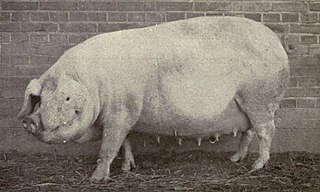
The Danish Landrace, Danish: Hvid Dansk Landrace, is a Danish breed of pig. It is of medium to large size, white in colour with a long body, fine hair, a long snout, and heavy drooping ears. There are two distinct varieties, the white and the piebald.

The American Landrace is an American breed of domestic pig. It is white in color, with a long body, fine hair, a long snout and heavy, drooping ears. Like all landrace pigs, it derives from the Danish Landrace.
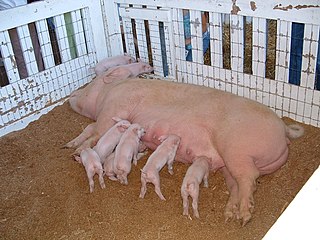
The American Yorkshire is an American breed of large domestic pig. It is the most numerous pig breed in the United States. It derives from pigs of the British Large White or Yorkshire breed imported from the United Kingdom or from Canada at various times from about 1830 to the mid-twentieth century.

The Essex is a breed of domestic pig originating in the United Kingdom.

The Berkshire is a British breed of pig. It originated in the English county of Berkshire, for which it is named. It is normally black, with some white on the snout, on the lower legs, and on the tip of the tail.

The Anglo-Nubian is a British breed of domestic goat. It originated in the nineteenth century from cross-breeding between native British goats and a mixed population of large lop-eared goats imported from India, the Middle East and North Africa. It is characterised by large, pendulous ears and a convex profile. It has been exported to many parts of the world, and is found in more than sixty countries. In many of them it is known simply as the Nubian.

The Poland China is an American breed of domestic pig. It was first bred in Warren County in Ohio, in the American Midwest. Its origins lie in a small number of pigs of Chinese type bought in 1816, which were cross-bred with a variety of breeds of European origin including the Berkshire. It was bred as a lard pig, and is among the largest of all pig breeds.
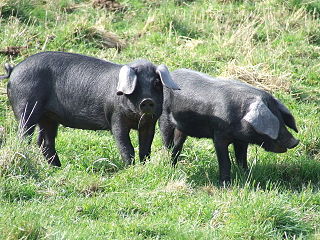
The Large Black pig is a British breed of domestic pig. It is the only British pig that is entirely black. It was created in the last years of the nineteenth century by merging the black pig populations of Devon and Cornwall in the south-west with those of Essex, Suffolk and Kent in the south-east. It is hardy, docile and prolific; it forages well and is suitable for extensive farming, but not well suited to intensive management.
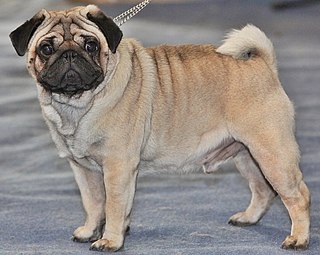
The Pug is a breed of dog originally from China, with physically distinctive features of a wrinkly, short-muzzled face, and curled tail. The breed has a fine, glossy coat that comes in a variety of colors, most often fawn or black, and a compact, square body with well developed and thick muscles all over the body.
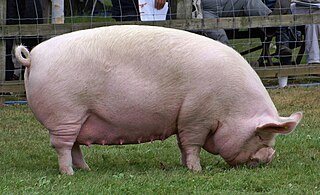
The Middle White is a British breed of domestic pig. It originated in Yorkshire, and derived from the Large White and the now-extinct Small White. It was recognised in 1852, and the first herd-book was published in 1884. It is a porker, reared for fresh pork, and is characterised by a short and sharply-upturned snout. After the Second World War it came close to extinction; although numbers have recovered somewhat, it is listed by the Rare Breeds Survival Trust as "priority" – the highest level of risk.

The Welsh is a breed of domestic pig native to Wales. It is a large white breed known for its hardiness in outdoor (extensive) farming, its long, pear-shaped body and its lop-ears. The breed was first mentioned in the 1870s, and after the Howitt committee report in 1955, became the third most common sire in the United Kingdom after the Large White pig and British Landrace pig. The Welsh pig experienced a decline in numbers in the late twentieth century because consumer demands had changed and the carcase was considered too fatty. In 2005 the breed was considered endangered and later came under the auspices of the Rare Breeds Survival Trust. Since then numbers have expanded somewhat, and by 2012, the registered breeding herd had increased to over 1000 animals.
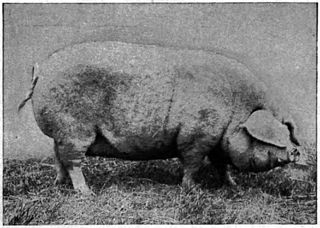
The Lincolnshire Curly Coat or Lincolnshire Curly-coated, also known as the Baston Pig, is an extinct British breed of domestic pig. It originated in, and was named for, the county of Lincolnshire, in the East Midlands. Like many other traditional pig breeds, it became rare after the Second World War. By 1970, it had disappeared. An older, still existing breed of similar looking pigs is the Hungarian Mangalica.
The Yorkshire Blue and White pig, also known as the Bilsdale Blue, or as the "Blood Breed", was a breed of domestic pig originating in the United Kingdom. It is now considered extinct.
The Cumberland was a breed of domestic pig that originated in the North of England; it was used to produce local delicacies like the Cumberland sausage and Cumberland ham. The breed became extinct in 1960, after changes in farming methods and a demand for less fatty meat led to it falling out of favour.
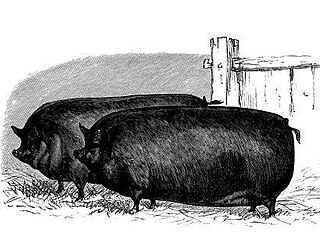
The Small Black or Suffolk pig was a breed of domestic pig originating in the United Kingdom during the nineteenth century. It is now extinct.
The Large White Ulster, or Ulster White, was a breed of domestic pig. Primarily bred for bacon production, it was the favoured breed of farmers in the north of Ireland up until the mid 20th century.
